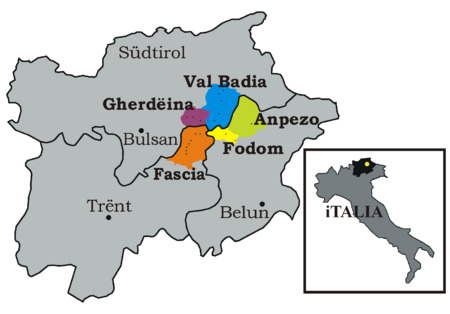Ladin
| Ladin Ladin |
||
|---|---|---|
| Spoken in: | ||
| Region: | Province of Belluno, Province of Bolzano-Bozen and Province of Trento | |
| Total speakers: | 30,000 | |
| Language family: | Indo-European Italic Romance Italo-Western Western Gallo-Iberian Gallo-Romance Gallo-Rhaetian Rhaetian Ladin |
|
| Official status | ||
| Official language in: | None | |
| Regulated by: | The office for Ladin language planning Ladin Cultural Centre Majon di Fascegn Istitut Ladin Micurà de Rü |
|
| Language codes | ||
| ISO 639-1: | None | |
| ISO 639-2: | roa | |
| ISO 639-3: | lld | |
| Note: This page may contain IPA phonetic symbols in Unicode. | ||
Ladin (Ladino in Italian, Ladin in Ladin, Ladinisch in German) is a Rhaeto-Romance language spoken in the Dolomite mountains in Italy between the regions of Trentino-Alto Adige/Südtirol and Veneto. It is closely related to the Swiss Romansh, Surselvan, and Friulian.
Ladin should not be confused with Ladino (also called Judaeo-Spanish), which is a Romance language derived mainly from Spanish, Hebrew, Turkish, and Greek.
It is spoken in:
- the following municipalities of the Province of Bolzano-Bozen:
- Ortisei
- Santa Crestina Gherdëina
- Sëlva
- Badia
- Corvara
- La Val
- San Martin de Tor
- Mareo
- the following municipalities of the Province of Trento (Val di Fassa):
- Canazei (Ladin Cianacei)
- Campitello di Fassa (Ladin Ciampedèl)
- Mazzin (Ladin Mazin)
- Pozza di Fassa (Ladin Poza)
- Vigo di Fassa (Ladin Vich)
- Soraga (Ladin Soraga -or- Sorega)
- Moena (Ladin Moena)
The Ladin spoken in the Fassa Valley (Ladin Val de Fascia, Italian Val di Fassa) is also subdivided into two further branches: "Cazét" (pronounced [kazɛt]) is spoken in the northern half of the valley, whereas "Brach" (pronounced [brak]) is spoken in the southern half. For example, in Cazét water is "ega" ("e" pronounced as /ɛ/), whereas in Brach it is "aga".
- the province of Belluno in:
- Livinallongo valley (Ladin Fèdom, German Buchenstein) and at
- Cortina d'Ampezzo (Ladin Anpëz)
It is officially recognized in Italy and has some official rights in the region of Trentino-Alto Adige/Südtirol, while it does not have official status in the province of Belluno (Veneto region).


See also
- Ladin alphabet
External links
- The office for Ladin language planning
- News - Noeles.net the first internet-news-portal in ladin language (ladin dolomitan / ladin standard). The main contents are about ladin culture, politics, society, and other.
- Ethnologue report on Ladin
- Weekly Paper - La Usc Di Ladins (The Voice Of The Ladins - in Ladin - different sections written in all the different sub-dialects), paper of the General Union Of The Ladins Of The Dolomites. Weekly news from the Ladin valleys in the Dolomites.
- Ladinienatlas ALD-I
- Linguistic Atlas of Dolomitic Ladinian and neighbouring Dialects - Speaking Linguistic Atlas
- Grzega, Joachim, Materialien zu einem etymologischen Wörterbuch des Dolomitenladinischen (MEWD), Eichstätt 2005.
|
|||||||||||||||||||||||||||||||||||||||||||||||||||||||||||||||||||||||||||||||||||||||||||||||||||||||||